
ICCROM_ICS11_History_en
.pdf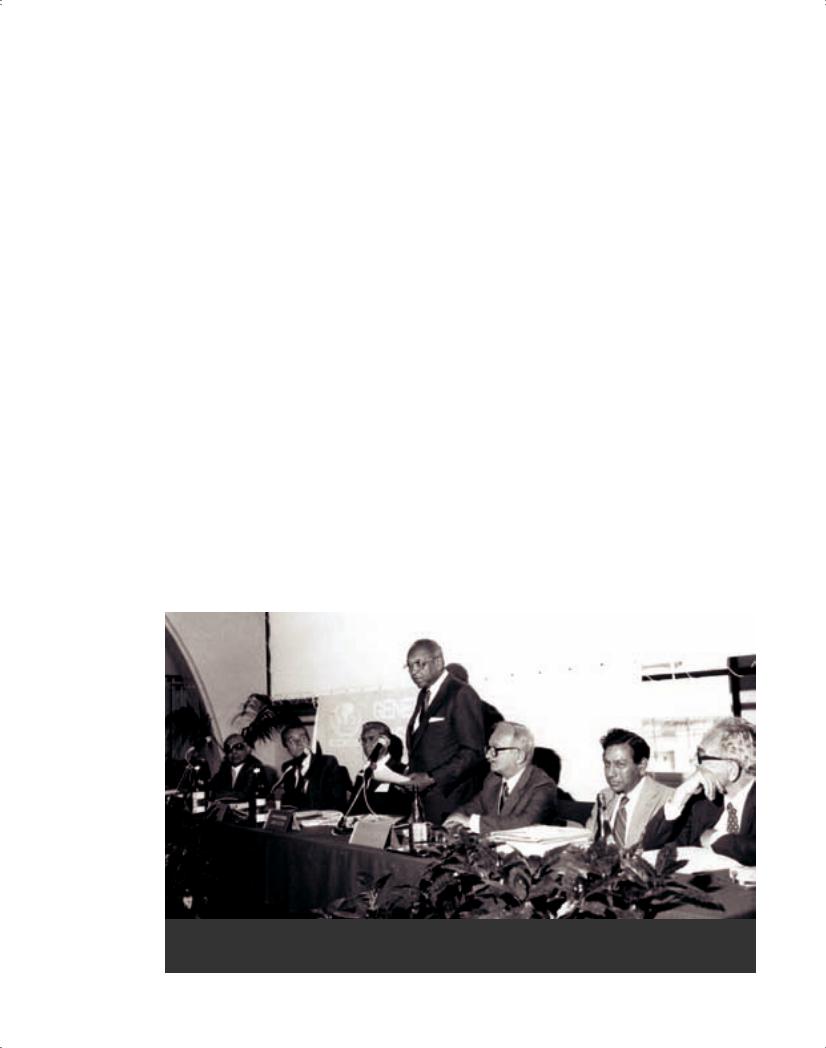
Director, and also all the members of ICCROM, the whole staff. … You [Jokilehto] and Gaël de Guichen were the two main partners from within the staff. Gaël was dealing with movable property, and you were the person related with everything concerning architectural conservation. With both of you, I had the feeling that the collaboration was very good, all along.”186
In 1983 the Director-General of UNESCO, Amadou Mahtar M’Bow, attended the XIII General Assembly of ICCROM, and referred to the impressive increase in the number of its Member States:
“This success is due primarily to the distinctive character of ICCROM’s work, resulting from the practical slant given to its research and from its constant concern with the possibilities of applying it. In addition, ICCROM endeavours to combine in its work, as the need arises, the most advanced technologies with the traditional techniques used in various countries. It thus demonstrates, through a quarter of a century’s practical experience, that it is possible to safeguard part of the immovable cultural heritage by techniques that are as simple as they are effective and whose main advantage is that they are accessible to many countries with limited resources. ...
However, ICCROM’s work is probably of the most decisive importance when it comes to
training. It is obviously a most important task to make available to experts in all branches of restoration work, from craftsmen to scientists, the widest possible range of new knowledge and techniques needed for the protection and preservation of cultural property.”
M’Bow concluded by calling for a special effort to make ICCROM’s services increasingly available to the international community. Collaborating closely with all the international organizations concerned, it should devise national training programmes in co-operation with Member States, and establish a “worldwide network of training centres by expanding or setting up national, regional, sub-regional, and international institutes.”187
Administration and policies
During this period the Chairpersons of the Council were Johan Lodewijks (1981 to 1986) and Paul Perrot 1986 to 1988).188 In collaboration with the principal representatives of the Council and based on the developments during his directorship, Erder decided to reform the organizational structure of ICCROM to meet the continuously evolving requirements. While the structure had been relatively simple, remaining more or less the same from the 1960s, the increasing tasks of the organization required a more articulate administrative structure. As a result, from January 1988, the structure was revised becoming more elaborate with the introduction of ‘sections’:
Figure 5 29
The Director-General of UNESCO, Amadou-Mahtar M’Bow, speaking at ICCROM’s General Assembly in 1983
80 |
ICCROM and the Conservation of Cultural Heritage. A history of the Organization’s first 50 years, 1959-2009 |
|
|

Having inherited from Feilden the programme already approved by the General Assembly for his first biennium as Director, Erder then revised the policies and strategies for future developments in three documents: ICCROM General Policy (1983),189
ICCROM Policy (1986)190 and ICCROM General Policy 1988-1989191. In the 1986 Policy, he referred to the previous document, noting that the proposed continuous growth of ICCROM was not necessarily feasible in practice:192
“In 1983 a Policy document summarized the growth of ICCROM activities, under the terms of reference given by the Statutes, and then indicated the desirable lines of further development. Implicitly, the document assumed a progressive and automatic expansion of the ICCROM budget and activities. In view of the changing of the attitude of several nations towards international organizations and of the wish expressed by some Member States of ICCROM to impose a ceiling on a continuous expansion of the budget, it is necessary to re-assess the aims of the organization and to present to the Member States a series of projects that they would be willing to support.
The nations supporting ICCROM must realize that the main reason for doing so is the wish to support an international project for conservation, the benefits, costs, qualities and defects of which should be evaluated globally. At a second level. Member States could also consider what direct and indirect advantages they are drawing from their participation in ICCROM; it is demonstrated that such advantages do exist and that funds invested in ICCROM are more cost effective than those allocated to bilateral international conservation projects and are a useful supplement to the money invested at home in national projects.”
The 1986 document went on to note that, while the in-house training programmes continued to be justified, it was necessary to reinforce regional activities. So he highlighted two initiatives: documentation by on-line system, and training in situ. The idea of a World-Wide Information System (based on an idea by Giorgio Torraca) took the form of: a) a network of machines and, b) a network of people. A central data bank would continuously receive abstracts of all available literature and unpublished texts. The data bank would be linked by means of satellite connections with reference laboratories in all Member States in a joint venture that collaborated with other important data banks
to obtain the widest coverage of relevant literature. The computer network would also be used as a low-cost communication system. To make such a network feasible, a new generation of conservation experts needed to be trained. ICCROM was already meeting this need at four levels: 1) training, 2) technical assistance, 3) research, and 4) publications, in line with its statutory functions. In terms of budget (which continued to be limited), Erder nevertheless proposed that over the next ten years the permanent staff needed to be increased by about 50% from the 27 members in 1986.193
The same document recalled that in the past ICCROM had been able to carry out operations in all parts of the world at a lower cost than other international organizations. It also had good knowledge of local conditions due to the presence of key professionals who had been in contact with it. Many dedicated experts (teachers, former course participants, etc.) would accept to work for fees that were lower than the usual international rates. Finally, there was the experience and dedication of ICCROM staff:
“It might appear that countries which already have advanced conservation laboratories could draw lesser benefit from the existence of ICCROM than developing countries where the conservation organization is relatively young and advanced scientific support is missing. On the contrary, experience proves that actually the most developed countries are able to draw the maximum benefit from ICCROM, because they have plenty of experts who can act as a counterpart to ICCROM and who know how to exploit the opportunities it offers. This is the reason why a major part of the ICCROM programme (a network of people) is designed to increase in each Member State the number of competent people who are able to work as counterparts in a common project.
Developing countries where the scientific support structure is still weak may benefit the most from the technical assistance plan (books, materials, fellowships, ad-hoc training programmes, etc.) and obtain support for the progressive expansion of their technical staff. Developed countries with strong scientific services may benefit particularly from the comprehensive data bank and network of sophisticated expertise. Bilateral programmes in conservation may greatly benefit from collaboration with ICCROM, as the ICCROM network can provide background information, local support and follow-up action not easily available through other means.”194
5 ICCROM comes of age (1977-1988) |
81 |
|
|
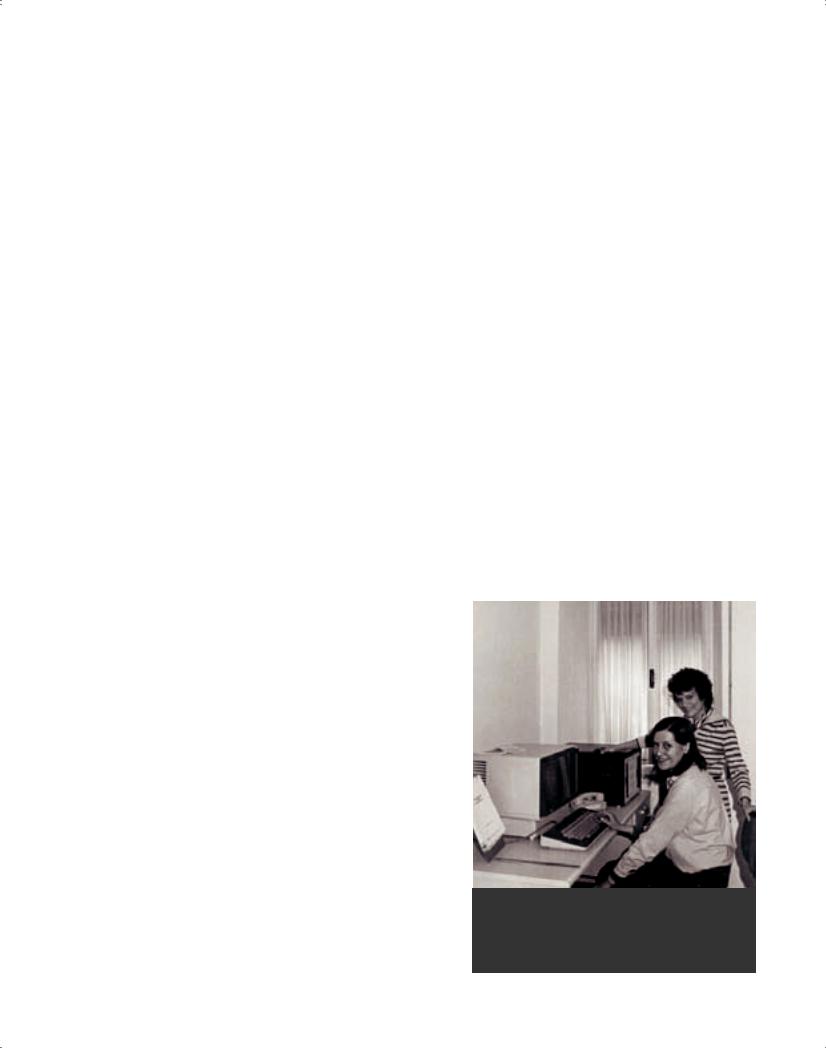
In 1986 these proposals might now seem rather utopian, considering that computer technology had not fully developed and the idea of the Internet was only beginning to emerge in the mid-1980s. In the end Erder’s proposed policy may not have been fully realized as forecast; but in reality the Internet has provided that international network that ICCROM was proposing in the mid-1980s, even though now, in hindsight more than twenty years later, it looks almost self-evident.
The third Policy statement during Erder’s directorship (in 1988) was prepared at a time of budgetary cutbacks when there was a conscious need to make the most of scarce resources. The reduction in the level of contributions of Member States that had been approved by the 22nd General Conference of UNESCO led to the complete revision of ICCROM’s budget in 1984. It had to achieve economies, for example by reducing the number of overseas lecturers on courses, selecting speakers who incurred lower interpretation costs, reducing the number of fellowships granted by ICCROM and seeking alternative sources of funding. At the same time, so as to respond to the increasing number of requests, the revised programme reflected a tendency towards greater decentralization and diversification of the activities.
Training and documentation
Documentation
The ICCROM General Policy of May 1983195 noted that: “all functions of ICCROM could be synthesized under a single heading: support of the technical organizations in charge of the conservation of cultural property in the Member States.” This support could be supplied by:
a)Distributing stored technical data;
b)Imparting information to individuals or groups through training systems;
c)Assisting offices or individuals in carrying out their job;
d)Finding (or creating) new information, when required, by means of research programmes.
The idea was launched to develop an international system of technical documentation, recording the information in a central computer databank, based on international standards and collaborating with other specialized institutions. Initially developed in the 1970s, personal computers were introduced in the early 1980s, notably IBM PCs for which Microsoft developed its software and which soon led to the production of clones. At the same time, Apple Macintosh introduced to the market their own models which proved particularly suitable for
imaging technology. ICCROM started introducing computers with a Macintosh in Administration, a Wang wordprocessor for publications, and a connection to an IBM mainframe computer for library cataloguing.
Computerization of the library holdings took several years of contacts with a number of institutions. In 1985 ICCROM made an agreement with the Getty Conservation Institute (GCI) to create a common ICCROM-AATA recording system for technical literature. The following year this developed into a bibliographic information database using the structure of the Canadian Heritage Information Network (CHIN) and a network involving ICCROM-AATA, the Canadian Conservation Institute, the Conservation Analytical Laboratory of the Smithsonian Institution and ICOMOS. The new databank known as the Conservation Information Network (CIN) was officially launched at the end of 1987 - after some ten years of planning and testing.
In 1981, the General Assembly invited the Council of ICCROM “to embark on a full-scale investigation of current conservation needs in training, documentation and fundamental research; requests that, in view of the development of an ICCROM policy on a medium-term basis, a full report be given, at its next Session.” It should examine the prevailing concepts of conservation training and the forecasts for their future evolution, the possible options, the
Figure 5 30
Cynthia Rockwell and Monica Garcia, responsible for ICCROM publications, at the first Wang word processor at ICCROM
82 |
ICCROM and the Conservation of Cultural Heritage. A history of the Organization’s first 50 years, 1959-2009 |
|
|
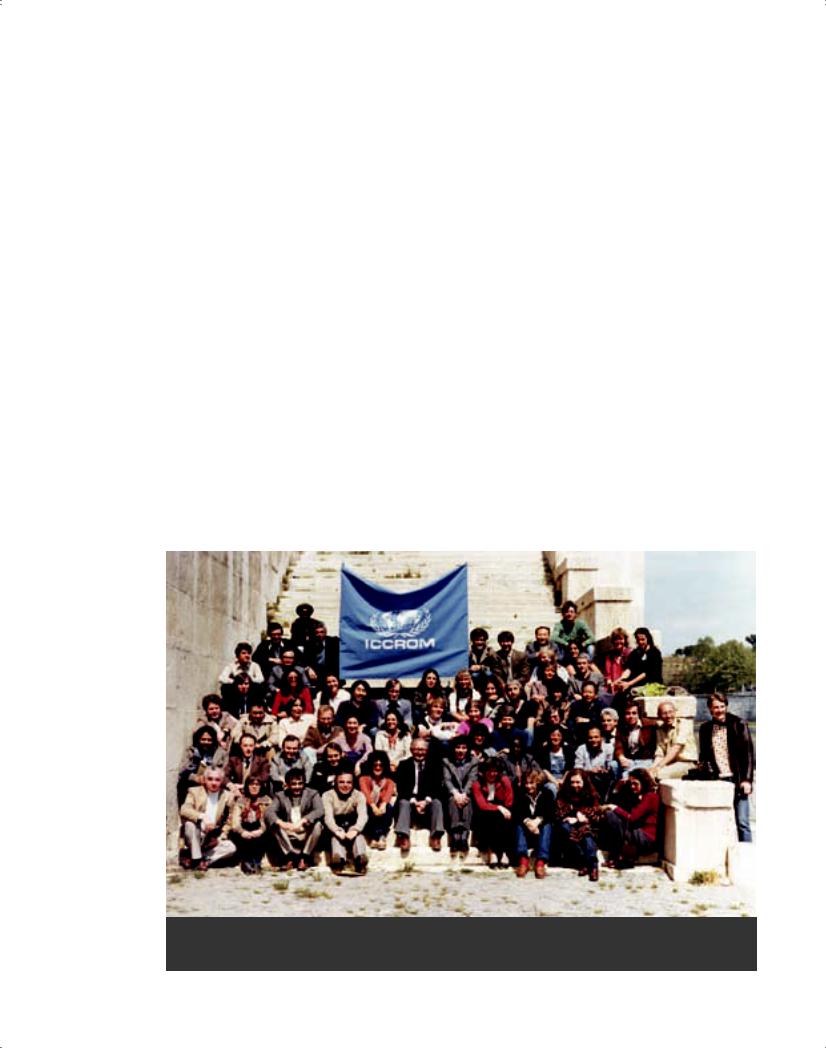
role of ICCROM, and ways to reinforce cooperation at different levels.196 A systematic survey of training programmes in different countries, whether national or international in scope, would allow ICCROM in its role as an international centre to respond and to develop proper tools for its courses. To some degree, this had been the policy during the previous directorship, with its specific programmes for preparing didactic materials and testing training units that could be exported to the national context in Member States. It is in this sense that Cevat Erder wrote in the introduction to his 1983 report to the Council:197
“The growth in the number of these training programmes has raised new problems and a variety of demands. Some of these call for an immediate response if they are not to lead to insuperable difficulties. As an international centre we try to provide assistance for the exchange of qualified teachers, to ensure requests for didactic material and to exchange information. We feel strongly the need for continuous research and a better understanding of correct conservation procedures. At the same time we realize the dangers inherent in speedy cures and short-term training programmes. We are reluctant to answer these types of request we
avoid a curriculum presented in pill form. We feel that the best solution is to be found in a situation where each country would have its own fully-fledged training programme. Just as in the domains of education and agriculture, basic training in conservation should also commence in the country of origin. This would allow us to develop our energies to refresher courses for trained and experienced technicians.”
As a result, ICCROM was giving increasing attention to the training of potential teachers on conservation courses by means of short training workshops that tested teaching techniques and didactic materials. ICCROM commissioned Marie Guillet, a training consultant, to prepare a report on training. The report (February 1982) was in two parts: the first part on Project for Teacher Training at ICCROM dealt with the different forms of adult training, particularly when undertaken in an international context; the second part, prepared at the request of the Cultural Heritage Division of UNESCO, focused on Training in the Fields of the Preservation and the Restoration of the National Heritage and examined issues of basic training, refresher training, the types of institutions to be involved and the teaching faculty required.
Figure 5 31
ICCROM’s course participants in spring 1982, on the bank of the river Tiber
5 ICCROM comes of age (1977-1988) |
83 |
|
|

In November 1982, a joint UNESCO-ICOMOS- ICCROM International Meeting for Coordinators of Training in Conservation produced clearly defined guidelines.198 The conference proposed that basic training be offered in the country of origin, but “ICCROM should study the possibility of creating new regional teaching programmes by contributing to their organization.” Great importance was given to training of teaching staff, and it was recommended that “ICCROM should develop its role as a meeting place for the exchange of experiences related to the teaching of conservation; it should facilitate the regular comparison and evaluation of programmes, factors essential to progress.” The conference had an impact on training strategies in ICCROM’s future programmes. One immediate follow-up was the inclusion, in 1983, in the International Architectural Conservation Course of a seminar on teaching in conservation. The seminar was coordinated by Alejandro Alva, Assistant Coordinator of ARC (employed as a staff member from 1 August 1979), and was attended by participants from Portugal, China, Sri Lanka, Belgium, India and USA.
Recognition of the profession of conservator/ restorer
The question of the recognition of the profession of conservators and restorers was a recurrent issue of debate. In 1986, Paul Philippot, in an editorial in the ICCROM Newsletter 12, touched on this problem in relation to cultural policy.199 He observed that the increasing popularization of restoration of works of art, and the lack of proper recognition of the profession of restorer, tended to result in the lack of a critical approach and the diffusion of popular fallacies regarding ‘restoration’. He asked: “how many original renderings are destroyed each year to satisfy the cult of bare stone - a pure projection of modern taste onto the ancient monument - unless the point is to replace at all costs the severe monochromy of a neoclassical façade with the ‘traditional’ image of the two tones of stone and brick?”200 Another problem was that of ‘museumification’, a relic of the historicist attitudes of the 19th century. The multiplication of exhibitions tended to alienate the public from authentic works of art, creating a glossy image that may not correspond to the original but may become like a shield to keep visitors (?) away. He proposed that restoration should not be seen as a purely technical task, but should be understood as a critical-cultural problem. Furthermore, proper training in the theory of restoration should be included in the curricula of history of art and archaeology, disciplines that are unfortunately not available in many countries. Finally, he argued, the
proper information and sensitization of the public are of fundamental importance.
Teaching faculty
The teaching tools that ICCROM developed over the years included the international courses, which became a kind of model that could be applied in different circumstances and were a real capital investment for the organization. Structure was not enough but needed to be complemented by appropriate staff and didactic materials. ICCROM’s professional staff members contributed to teaching, and there were temporary assistants who helped run the courses. These were usually former participants of the same courses, who could consolidate their know-how and later apply it in their home countries. A good proportion of former ICCROM participants soon advanced to leading positions in their countries. Another training tool consisted of the international faculty that was invited to teach. Even qualified national experts needed an adjustment period to be able to communicate with the international audience of the courses whose members had different backgrounds and often different languages.
Theory vs practice in training
One of the principles of ICCROM’s training programmes was to combine theory and practice. This had always been the idea in the development of the Architectural Conservation Course (ARC). The surveys by participants of ARC of historic buildings in Rome and in historic urban areas in Capua (1971) Tivoli (1972) and Trogir (1974) in Yugoslavia were undertaken in close collaboration with the relevant authorities; some even led to publication of their results.201 Study tours in the Mediterranean region complemented the teaching, benefitting from the international collaboration that developed in the 1970s and taking advantage of national case studies in various countries. All teaching used documentary material, handouts and bibliographies. Lecture notes prepared by faculty members for use on the course were sometimes later published as a series of simple but informative handbooks.
The International Course on the Conservation of Mural Paintings presented a parallel though slightly different situation. Jointly organized with the Istituto Centrale del Restauro (ICR), it drew upon the theoretical and practical experience of the ICR and the research undertaken by Philippot and the Moras. The courses demonstrated conservation theory during field projects such as that at Sermoneta that required a systematic analysis of the significance and state of conservation of selected mural paintings.
84 |
ICCROM and the Conservation of Cultural Heritage. A history of the Organization’s first 50 years, 1959-2009 |
|
|
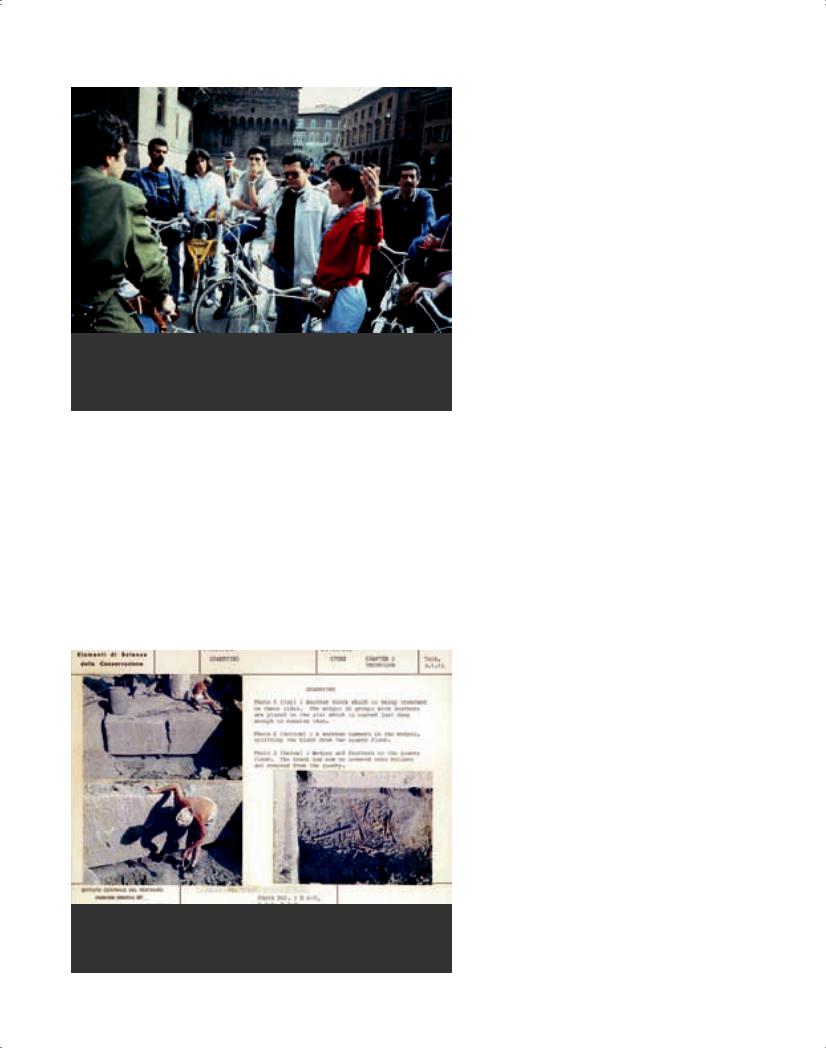
Figure 5 32
The International Architectural Conservation Course (ARC84) during a field trip to Ferrara, guided by City Architect Carlo Cesari (in the centre) and Jeanne Marie Teutonico (right)
Didactic materials for science and technology
In the mid-1970s, Giorgio Torraca had conceived the Course on the Fundamental Principles of Conservation (later named Course on Conservation Science and then, from 1981, Scientific Principles of Conservation). This course was innovative in bringing together many different disciplines but needed proper teaching materials that did not exist. ICCROM therefore collaborated with specialized institutions and laboratories on a series of research projects with the aim of providing the necessary
Figure 5 33
A didactic card on quarrying prepared by Peter Rockwell for training in stone conservation
teaching tools. The research also led to the collection of samples of materials and bibliographies on specific subjects. In 1984, Gaël de Guichen noted that there had been several international conferences which had repeatedly requested ICCROM to help improve the circulation of didactic material, not an easy task. UNESCO had already reported that Africa was most in need of conservation training. This called for a special effort to assist by means of a technical assistance programme and providing information on didactic material that could be reproduced or purchased.202
The need to train the trainers led to a series of seminars on the Formation of Didactic Materials and Teaching Skills, co-ordinated by Robert Ferguson (Institute of Education, University of London). Their aim was to improve different aspects of teaching skills. The seminar was first organized in 1984 in the form of a five-day seminar at the end of regular ICCROM courses, thus allowing their participants to opt to take part. The increasing interest in this course led it to be held annually and then to be prolonged to two weeks. In the 1990s, the course was integrated into PREMA and associated programmes, with the systematic involvement of former teachers and participants and regular programme reviews. Based on their involvement with these seminars, Robert Ferguson and Elizabeth Pye prepared a joint publication, Our Students and Ourselves, in which they concluded the introduction as follows: “Our long-term goals should be to design courses which encourage growth, critical thinking and the ability to take appropriate creative action in specific contexts. We take the approach of educators who believe in the importance of information and the development of skills. In the last analysis, however, we are concerned with educational processes which outlast individual courses and combine knowledge and training with practical activity. It is an activity which is the business of our students and ourselves.”203
Research Training Units and related field projects
Initially, ICCROM’s research budget was spent mainly to support international meetings to exchange information and report on research. With the increasing number of all types of meetings, ICCROM decided to focus on specialized meetings of limited numbers of experts and on practical ways of stimulating research in conservation by promoting national projects and co-operating through panels of experts. It had a small Research Unit which had been working on a number of projects associated with building materials.
5 ICCROM comes of age (1977-1988) |
85 |
|
|
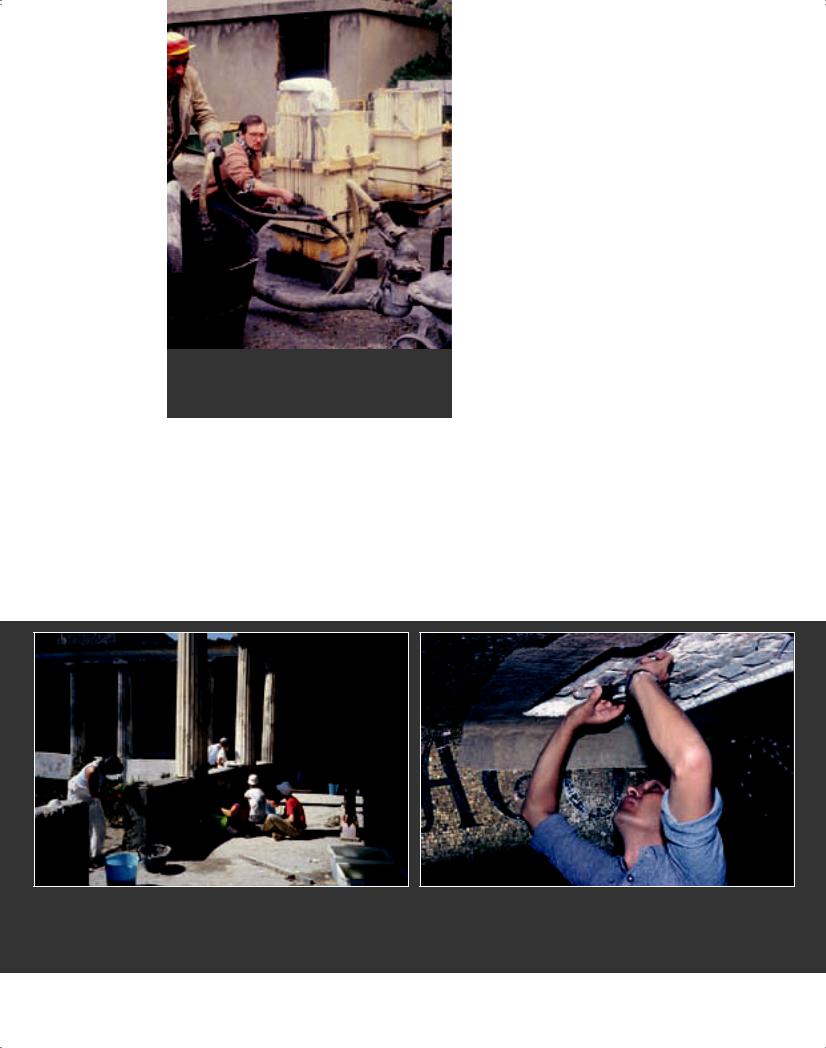
Figure 5 34
Mortar mixture being prepared by a team directed by G. Torraca (in picture: Jef Malliet)
At the end of 1978 some fellowships became available from the European Economic Community (EEC), and these were used to provide advanced training for former ARC course participants. In 1978-79 two units, each composed of two students and guided by a specialist in the field concerned, were working on petrography and on mechanical testing, using the facilities of the University of Rome. With new scholarships made available, a second phase continued
from 1980 to 1981 under the direction of Torraca, focusing on the preparation of lime mortars mixed with different additives, and testing their mechanical, chemical and physical properties. In the next phase in 1982, the mortars were used for grouting experimental walls and testing the results which were then applied for consolidating murals in a restoration project at the archaeological site of Pompeii under the supervision of Paolo and Laura Mora. The project concerned the restoration and protection of part of the courtyard decoration in the House of the Menander, including the design of a protective shelter.204 The grouts were further tested on consolidation of mosaics at a Roman villa at Lauro di Nola (Italy).
The results were presented at the third conference of the International Committee for the Conservation of Mosaics (Aquileia, Italy, October 1983), organized by ICCROM under the patronage of the local authority and the support of UNESCO and the Italian Department of Fine Arts.205 These results proved particularly useful for the consolidation of fragile archaeological sites and mosaic walls. The testing confirmed that the grouting did not cause negative side-effects. The Research Training Units and the development of low-cost but efficient teaching tools aimed at providing materials that could be exported to various regions. The Units became another useful training tool that was used in different problem areas including conservation of mural paintings, mosaics and archaeological sites and for structural consolidation in industrial archaeology.
Figure 5 35
Conservation of wall paintings in Pompeii
Figure 5 36
Conservation of mosaics in Torcello
86 |
ICCROM and the Conservation of Cultural Heritage. A history of the Organization’s first 50 years, 1959-2009 |
|
|
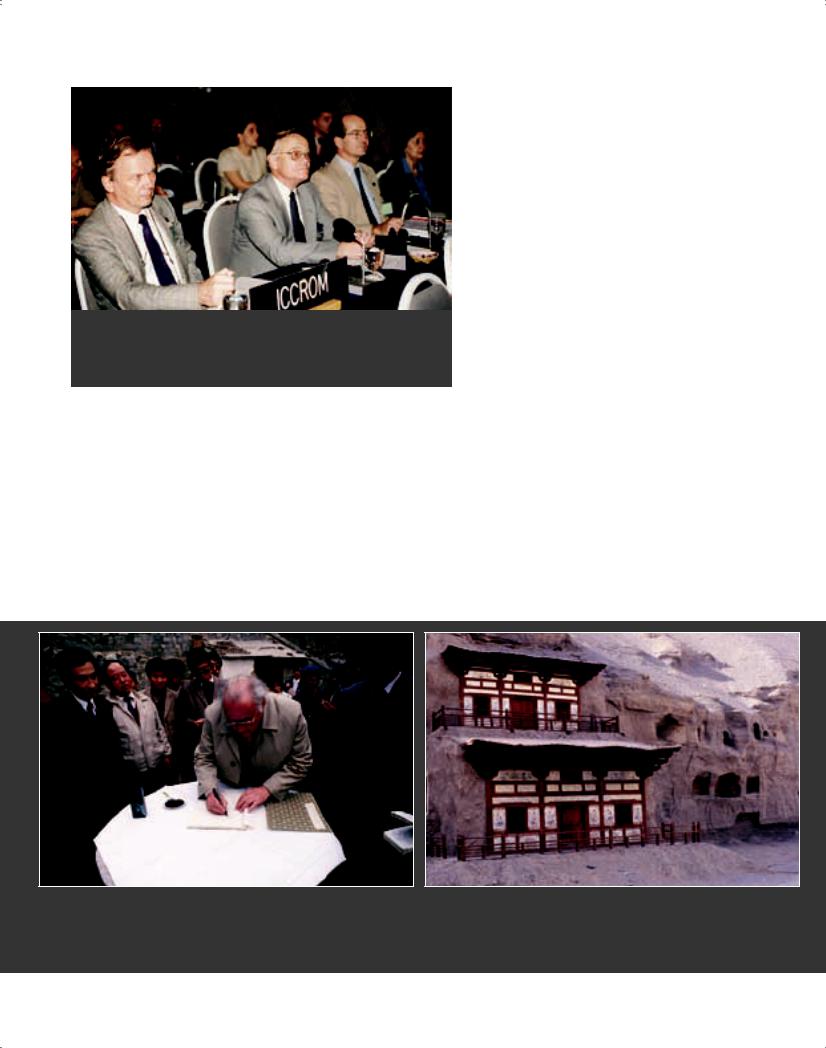
Figure 5 37
World Heritage Committee meeting in Phuket (Thailand, 1994) J. Jokilehto (ICCROM), H. Cleere, J-L. Luxen and C. Añón Feliu (ICOMOS)
Projects undertaken on contract
The long-term project agreed in 1979 to assist the Department of Fine Arts of Thailand with increasing the professional competence of its staff in the conservation of mural paintings continued under the co-ordination of Paul Schwartzbaum. Under UNESCO contract ICCROM in 1983 conserved wall paintings and external murals in the Temple of Kubyaukgyi at Pagan in Burma, the first phase of a pilot project that continued in the following years, co-ordinated by Schwartzbaum
and Donatella Zari together with four trainees and two chemist-restorers of the Department of Archaeology.206 As part of the project, the experimental hydraulic lime technique already developed by the ICCROM mortars Research Training Unit was used in external test areas. Similar projects took place in Italy with Giorgio Torraca and Paolo and Laura Mora provided expertise on stucco restoration in Palladian buildings in Vicenza and Padua.
In 1981 ICCROM started participating in the UNESCO-funded projects for the conservation of mural paintings in Montenegro that have already been mentioned, leading to publication of a book describing the post-earthquake situation for fund-raising purposes.207 Under UNESCO contract, ICCROM sent architect Giorgio Lombardi (Italy) to advise the Algerian Directorate of Antiquities, Archaeology, Monuments and Sites in drawing up a restoration programme, and to advise on development of a pluri-disciplinary team for the restoration of Al Qala’a of Beni Hammad, a site inscribed on the List of World Heritage in Danger. Many of these projects included training components and in many cases ICCROM invited professionals linked with the projects to attend specialized courses at ICCROM.
International and regional collaboration
ICCROM continued its collaboration with the Regional Centres of UNESCO such as the Arab
Figure 5 38
UNESCO monitoring mission to the first six Chinese World Heritage sites in 1988 (Bernard Feilden, Carlo Giantomassi and Jukka Jokilehto, in Taishan); in the picture Feilden signing a visitor book
Figure 5 39
Mogao Caves, China, inscribed on the World Heritage List in 1987
5 ICCROM comes of age (1977-1988) |
87 |
|
|
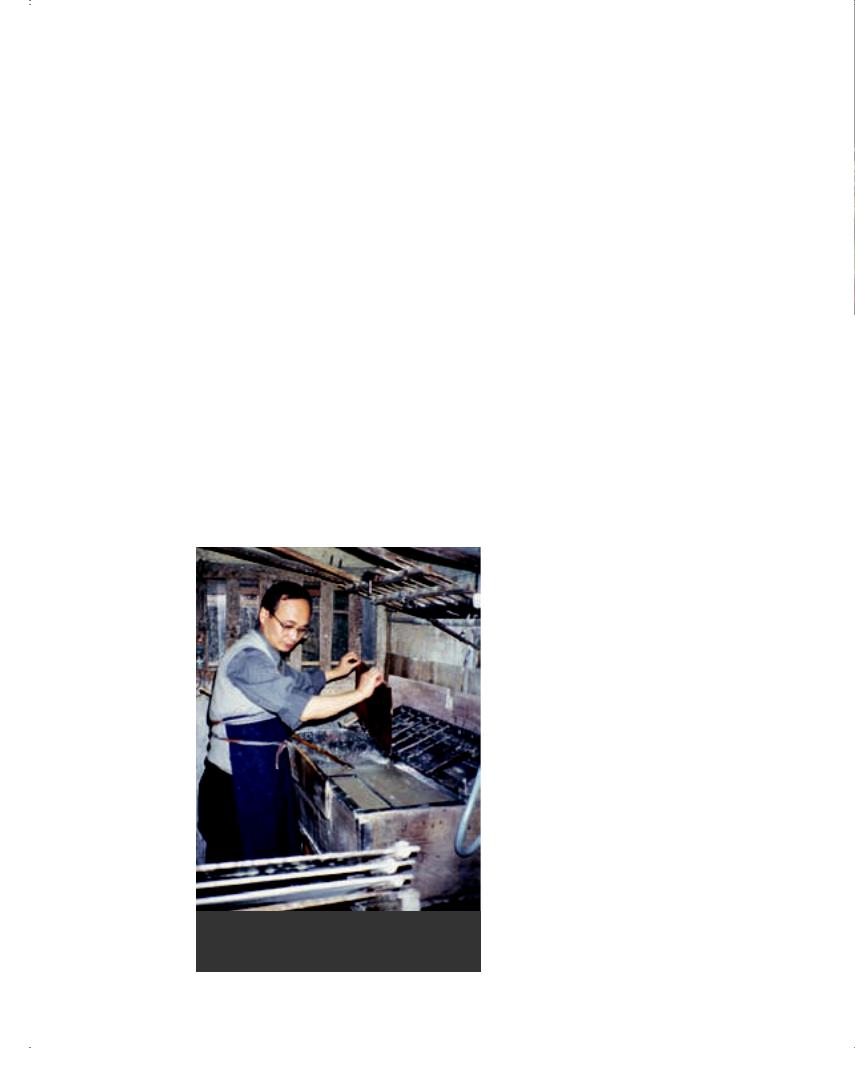
Regional Centre in Baghdad, and with national conservation centres, for example the National Research Laboratory for Conservation in New Delhi. Under the direction of O.P. Agrawal, Honorary Representative of ICCROM for South and South-East Asia, it was to play a role for the benefit of the entire region in terms of information management, training and technical cooperation, organizing regional conservation workshops on various topics.
Of the UNESCO Regional Centres, ICCROM helped organize in 1983 a course on the Conservation of Arabic-Islamic Architecture in Baghdad and supported the training activities of SPAFA in Thailand. It also provided support to Colin Pearson at the UNESCO Regional Conservation Centre at the Canberra College of Advanced Education in Australia which was developing a five-year plan for the development of conservation in the region.
In 1981, ICCROM signed an agreement with the Tokyo National Research Institute of Cultural Properties to second Katsuhiko Masuda to UNESCO, and from UNESCO to ICCROM, to carry out a training programme for western restorers in the traditional techniques of restoration of oriental art objects on paper. The large number of applications led to the agreement being extended to 1984 and eventually it resulted in a regular international course
Figure 5 40
Japanese paper course at ICCROM (Katsuhiko Masuda)
on paper conservation held in Japan, with others held in Austria.
PREMA Programme for Sub-Saharan Africa
As a logical follow-up to the regional initiatives undertaken in Sub-Saharan Africa since 1981, ICCROM decided to establish a Course for Preventive Conservation for Technicians and Restorers Working in African Museums South of the Sahara (PREMA). As Patrick Wamulungwe, Secretary of the Zambian National Heritage Conservation Commission, said in a speech in Livingstone: “Preventive conservation is an applied skill that involves thinking about, planning and designing facilities and implementing effective and efficient procedures to guarantee the safety of museum collections at minimum cost, but maximum efficiency.”208
The first PREMA course targeted French-speaking Africans and took place in late 1986, with the participants who successfully passed the exams being awarded a diploma from the Université de Paris I, La Sorbonne. Co-ordinated by Gaël de Guichen together with Catherine Antomarchi and two assistants, the course was financed through fundraising, the first important fundraising campaign of ICCROM and one that raised nearly US $400 000. Some of this money was earmarked for research and for preparing the second course targeted at English-speaking African countries. In the short term, the objective of PREMA was to teach fundamental principles of conservation (prevention and maintenance) adapted to African museum collections. In the long term the aim was “to ensure the conservation of the African cultural heritage and to establish a network of African professionals who can take charge of training related to preventive measures for the conservation of African cultural property.”209 Initially ICCROM organized the course in Rome for lack of a suitable location in Africa, but in the long-term the aim was to transfer the course to Africa once the necessary conditions had been guaranteed.
Other training outside ICCROM
ICCROM staff was increasingly participating in organizing and teaching conservation training programmes in different parts of the world. Examples in 1985 include the Course on Preventive Conservation (Cairo and Edinburgh); an International Course on Preventive Measures for the Protection of Cultural Property in Earthquake-Prone Regions (Skopje, Yugoslavia); a Course on Climate Control at the University of London; a Conference on Preventive Conservation in Museums (York, UK); a Course on Humidity in Historic Monuments (Lucknow and Goa, India); and a Post-Graduate
88 |
ICCROM and the Conservation of Cultural Heritage. A history of the Organization’s first 50 years, 1959-2009 |
|
|
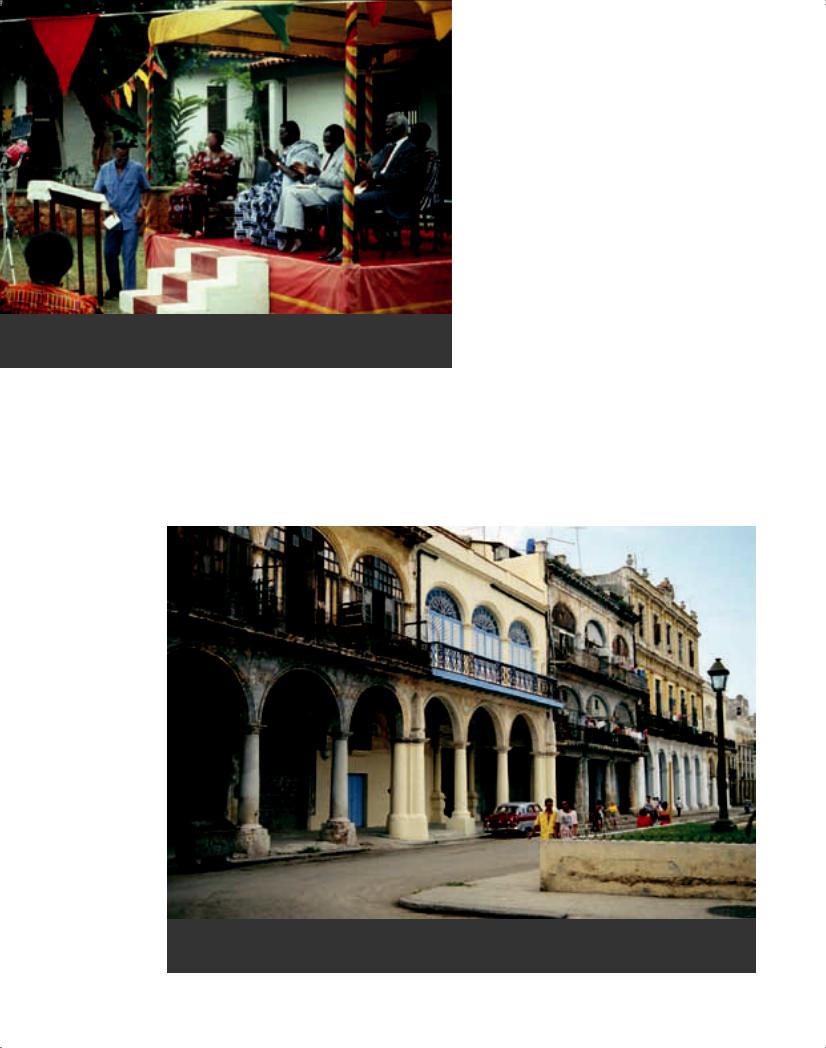
Figure 5 41
PREMA programme; ceremony in Ghana
Course on Principles of Architectural Conservation in Havana, Cuba.
In 1986, the list of collaboration included a Course on the Conservation and Maintenance of Archaeological Sites (Easter Island, Chile); a Course on Preventive Conservation (Niamey, Niger); a
Figure 5 42
A street in the historic centre of Havana, Cuba
Course on Introduction to the Conservation of Cultural Property (University of Victoria, Canada); a Summer School at the Institute of Archaeology, University of London; a Workshop on Structural and Functional Rehabilitation of Housing in Historical Buildings located in Seismic Regions (Mexico City, Mexico); a Course on the Conservation of Historic Structures at the University of York, UK; a Seminar on Climate Control (Belo Horizonte, Brazil); a Course on the Conservation of Mural Paintings (Bogota, Colombia); a Regional Postgraduate Course on the Principles of Architectural Conservation, in Havana, Cuba; and a Conference on Care and Preservation of Ethnological Materials (Ottawa, Canada). Several of these courses were repeated, even becoming regular training programmes.
ICCROM also hosted foreign university programmes at its premises in Rome, organizing suitable tours in Italy. A four-week conservation course for students of Yale University, organized by Torraca in collaboration with Laura and Paolo Mora, included working sessions at the archaeological site of Pompeii. Similar courses were organized for students of several universities, especially from the USA and Canada, but also from various European countries.
5 ICCROM comes of age (1977-1988) |
89 |
|
|
